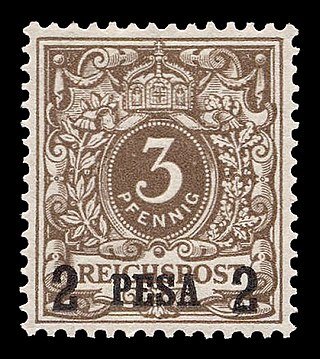
This is a survey of the postage stamps and postal history of German East Africa.
The Congolese franc is the currency of the Democratic Republic of the Congo. It is subdivided into 100 centimes. However, centimes no longer have a practical value and are no longer used. In April 2024, 2,800 francs was equivalent to US$1.

The Katangese franc, was the currency of the unrecognized State of Katanga between 1960 and 1963 during its brief period of independence from the Republic of the Congo. It replaced the Congolese franc at par and was consequently initially equal to the Belgian franc. This established an exchange rate of 50 francs = 1 U.S. dollar. Just before Katanga was re-annexed by Congo, the exchange rate had fallen to 195 francs = 1 U.S. dollar. The currency was replaced at par by the Congolese franc.
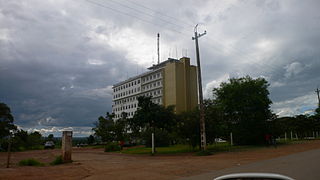
The University of Lubumbashi, also known by the acronym UNILU, is one of the largest universities in the Democratic Republic of the Congo. It is located in Lubumbashi in Haut-Katanga Province, previously Katanga Province. The campus is located in the northern part of the city, west of the airport.
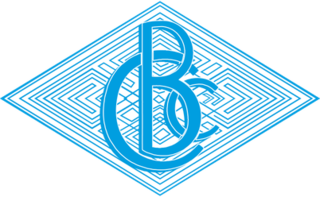
The Central Bank of the Congo is the central bank of the Democratic Republic of the Congo. The bank's main offices are on Boulevard Colonel Tshatshi in La Gombe in Kinshasa.
The Ruanda-Urundi franc was a currency issued for the Belgian mandate territory of Ruanda-Urundi in 1960–62 which continued to circulate within its successor states of Rwanda and Burundi until 1964. The currency replaced the Belgian Congo franc which had also circulated in Ruanda-Urundi from 1916 to 1960 when the Belgian Congo became independent, leaving Ruanda-Urundi as the sole Belgian colonial possession in Africa. With the independence of Rwanda and Burundi in 1962, the shared Ruanda-Urundi franc continued to circulate until 1964 when it was eventually replaced by two separate national currencies.
The Union Zaïroise de Banques (UZB), known before 1971 as the Banque Belge d'Afrique and after 2005 as the Union des Banques Congolaises, was a bank based in Kinshasa. It was established in 1929 by Belgium's Banque de Bruxelles as its main African banking affiliate, and remained majority-owned by European banks until nationalization in 1995. Its activities were liquidated in the early 2010s.

Burundi has issued postage stamps for national use since achieving independence on 1 July 1962. The country was formerly a part of the Belgian territory of Ruanda-Urundi and before 1962 used those postage stamps.
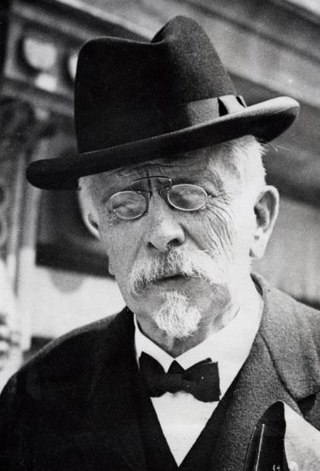
The Belgian Minister of the Colonies was a Belgian parliamentarian who was responsible for the territories of the colonial empire in Central Africa from 1908 to 1962, comprising the colony of the Belgian Congo (1908–60) and the international mandate of Ruanda-Urundi (1916–62). The exact title was changed on several occasions.

This is a survey of the postage stamps and postal history of Rwanda. The Republic of Rwanda is a landlocked country located in the Great Lakes region of eastern-central Africa, bordered by Uganda, Burundi, the Democratic Republic of the Congo and Tanzania.
This is a survey of the postage stamps and postal history of Djibouti, known as the French Territory of the Afars and Issas before independence, and as French Somaliland before that.

Frans Hubert Edouard Arthur Walter Robyns (1901-1986), known as Walter Robyns, was a Belgian botanist. His son, André Robyns (1935–2003), was also a botanist.

The history of the Jews in the Democratic Republic of the Congo can be traced back to 1907, when the first Jewish immigrants began to arrive in the country. The current Jewish Congolese population is mostly of Sephardi background.

The African territories of Ruanda and Urundi came under Belgian control as Ruanda-Urundi after they were seized from Germany during World War I in 1916. They had previously formed part of German East Africa.
White Congolese are the people from the Democratic Republic of the Congo who are of European descent and are not part of another racial group.
The Archives Africaines of the Belgian Federal Public Service Foreign Affairs in Brussels contains records related to colonial Congo Free State, Belgian Congo and Ruanda-Urundi, 1885-1962. The archives was transferred in 1960 to the Ministère belge des Affaires étrangères. In 2015 the archives went to the Belgian State Archives, an arrangement expected to continue until 2018. The Archives Africaines includes "the archives of the former Ministry for Colonies, the archives of the Governor-General of the Congo, and the files on former colonial personnel ."
Pierre Leroy (1909–1985) was a Belgian lawyer and colonial administrator.
Count Albert-Émile de Beauffort was a Belgian colonial administrator.
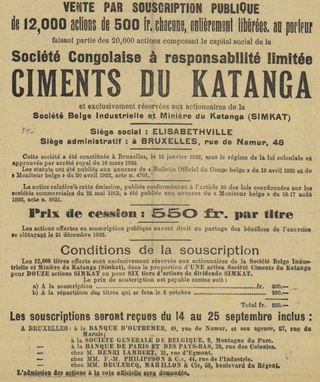
Ciments du Katanga is a company in the Democratic Republic of the Congo that makes cement and related products. It was established during the copper boom of the early 1920s to supply the new mining and refining companies, including worker housing and industrial construction.
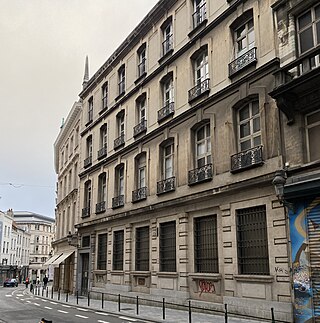
The Banque Centrale du Congo Belge et du Ruanda-Urundi (BCCBRU) was a short-lived central bank whose territorial remit covered Belgian Congo and Ruanda-Urundi. It was established in 1952 to take over monetary authority from the private-sector Banque du Congo Belge upon expiry of the latter's issuance charter. Made obsolete by Congolese independence in mid-1960, it finally ceased activity on 31 August 1961.

















